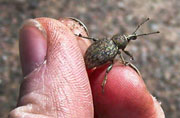A cost-sharing program to encourage the application of biocontrol nematodes for managing alfalfa snout beetle shas been funded for 2015 by the NNY Agricultural Development Program Small Grants Program and is being implemented by Cornell University Cooperative Extension Field Crops and Soils Specialists in Jefferson, Lewis, St. Lawrence, Franklin, Clinton and Essex Counties and the Shields’ Lab at Cornell University.
Click here for program guidelines
For more information and to enroll, contact your local CCE Specialist:
Jefferson and Lewis counties: Mike Hunter, 315-788-8450 ext 266, meh27@cornell.edu
Clinton, Essex, Franklin and St. Lawrence counties: Kitty O’Neil, 315-854-1218, kitty.oneil@cornell.edu

Alfalfa Snout Beetle (ASB) is the major limiting factor in alfalfa production and stand longevity in all Northern New York counties. Uncontrolled, ASB can destroy a new alfalfa seeding in just a year or two. Field losses cost producers from $250 to $400 per acre from this insect. Over the past 25+ years, with funding support from the farmer-driven Northern New York Agricultural Development Program, an ASB biological control program has been developed by the Shields’ Lab at Cornell University that uses native, insect-attacking nematodes (biocontrol nematodes). To date, approximately 8,000-10,000 acres of alfalfa have been treated with these ASB-biocontrol nematodes on about 65 farms.
Some farms have inoculated the majority of their alfalfa acres while a number of farms have only inoculated 1-2 fields. Early adopting producers, who have treated multiple fields within an area have reported a significant decline of ASB on their farm and have returned to growing alfalfa successfully. The decline in ASB population in an area has taken 3-5 years after multiple fields were treated. In contrast, farmers who have treated only a couple of fields in an area are not seeing much impact on their ASB populations. For these reasons, this cost-sharing program was developed to encourage more growers to treat fields within problematic ASB areas.
On-farm research the past 7 years indicates that just a single application of biocontrol nematodes is required in a field because these biocontrol nematodes persist in the field for many years, including across multiple year rotations to row crops.
Many farmers are hopeful that planting the new ASB-resistant alfalfa varieties will solve their ASB insect problems, but these varieties are currently only moderately resistant and can be overrun by high ASB populations. For example, heavy ASB pressure wiped out all of Cornell’s resistant alfalfa lines planted in a Lewis County field comparison in 2014.
To effectively control ASB, a dual management strategy must be used. ASB populations must be reduced using biocontrol nematodes before ASB resistant alfalfa can be used effectively. The Northern New York Agricultural Development Program has funded the selective breeding of ASB-resistant alfalfa varieties.